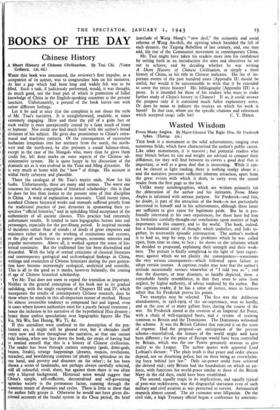Chinese History
A Short History of Chinese Civilisation. By Tsui Chi. (Victor Gollancz. us. 6d.)
WHEN this book was announced, the reviewer's first impulse, as a compatriot of its aumor, was to congratulate him on his initiative. At last a gap which had been long and widely felt was to be filled. Such a task, if judiciously performed, would, it was thought, do much good, not the least part of which is promotion of fuller knowledge of China in' the English-speaking countries at the present juncture. Unfortunately, a perusal of the book leaves one with rather different feelings.
Let it be said at once that the complaint is not about the style of Mr. Tsui's narrative. It is straightforward, readable, at times extremely engaging. Here and there the pill of a grim fact or stark reality is most unexpectedly coated by a faint touch of irony or humour. Nor could one find much fault with the author's broad divisions of his subject. He gives due prominence to China's extramural Sind maritime contacts. Of the consequences of successive barbarian irruptions into her territory from the north, the northwest and the north-east, he also presents a sound balance-sheet, except in the case of the Mongols who, more than he gives them ' credit for, left deep marks on some aspects of the Chinese administrative system. He is quite happy in his discussion of the dramatic art as it was evolved in the Yuan and Ming dynasties. He is very much at home with the " how " of things. His account is withal fairly coherent and plausible.
There the catalogue of Mr Tsui's merits ends. Now for his faults. Unfortunately, these are many and serious. The worst one concerns his whole conception of historical scholarship: this is that he does far less than justice to the present state of that discipline in China. A word of explanation is necessary. Until recent times, standard Chinese historical works and manuals suffered greatly from the traditional practice of past dynasties in sponsoring their respective "official histories," and in upholding blind acceptance of the authenticity of all ancient classics. This practice had extremely unfortunate results. It tended to turn logographic heroes into real personages, especially for the pre-Shang period. It inspired records of incidents rather than of trends ; of deeds of great emperors and ministers rather than of the working of institutions and systems, or the play of such forces as power groups, economic interests and popular movements. Above all, it worked against the sense of historical continuity. But the traditional line has been discredited and discarded. With the help of textual criticisms of classical literature and contemporary geological and archaeological findings in China, writings and researches of Chinese historians during the past generation have become increasingly ecological, analytical and scientific. This is all to the good as It marks, however belatedly, the coming of age of Chinese historical scholarship.
Yet Mr. Tsui does not seem to regard the transition as important. Neither in the general conception of his book nor in its gradual unfolding, with the single exception of Chapters III and IV, which incorporate the results of contemporary Chinese research, does he show where he stands in this all-important matter of method. Hence his almost irresistible tendency to compound fact and legend, even in cases where known authorities exist for a purely factual treatment ; hence the inclusion in his narrative of the hypothetical Hsia dynasty ; hence those useless speculations over logographic figures Me Pin Ku, Nii Wo, San Huang, Wu Ti, &c.
If this unrealism were confined to the description of the prehistoric era, it might still be glossed over, but it obtrudes itself every -now and then throughout the narrative, so that one cannot. help feeling, when one lays down the book, the strain of having had to remind oneself that this is a history of Chinese civilisation. The reader has been through curious company (gods, demi-gods, brutes, freaks) strange happenings (dreams, trances, revelations, miracles), and bewildering contrasts (of plenty and splendour on the one hand, and poverty and disasters on the other); he has been shown a series of landmarks, not perhaps always carefully selected, still all colourful, vivid, sheer, but against them there is too often only a blurred background. Historical sense would suggest that China's simple, self-sufficient, decentralised and self-governing agrarian society is the permanent factor, running through the transient mazes of dynasties and cycles. There is little to show that the author fully grasps it. Otherwise he would not have given disjointed accounts of the feudal system in the Chou period, the brief interlude of Wang 1Viang's "new deal," the economic and social reforms of Wang An-shih, the uprising which heralded the fall of each dynasty, the Taiping Rebellion of last century, and, one may add, the rise of the Communist movement in contemporary China. Mr. Tsui might have taken his readers more into his confidence by setting forth in an introduction the aims and objectives he set out to achieve, and by deciding whether he was writing A Short History of Chinese Civilisation, or simply a short history of China, as his title in Chinese indicates. His list of important events of the past hundred years (Appendix II) should be useful, but would it be unreasonable to wish that it be extended to cover the entire history? His bibliography (Appendix III) is a poser. Is it intended for those of his readers who want to make further study of China's history in Chinese? If so, it could answer the purpose only if it contained much fuller explanatory notes. Or does he mean to indicate the sources on which his work is based? In that case, where are the specific citations and references which accepted usage calls for? C. Y. HSIEH.






















 Previous page
Previous page